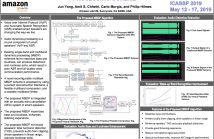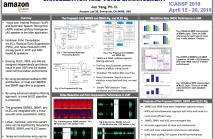
- Read more about Semi-Supervised Optimal Transport Methods for Detecting Anomalies
- Log in to post comments
Building upon advances on optimal transport and anomaly detection, we propose a generalization of an unsupervised and automatic method for detection of significant deviation from reference signals. Unlike most existing approaches for anomaly detection, our method is built on a non-parametric framework exploiting the optimal transportation to estimate deviation from an observed distribution.
- Categories:
 54 Views
54 Views
- Read more about FULLY-NEURAL APPROACH TO HEAVY VEHICLE DETECTION ON BRIDGES USING A SINGLE STRAIN SENSOR
- Log in to post comments
Bridge weigh-in-motion (BWIM) is a technique for detecting heavy vehicles that may cause serious damage to real bridges. BWIM is realized by analyzing the strain signals observed at places on the bridge in terms of bridge-component responses to the axle loads. In current practice, a BWIM system requires multiple strain sensors to collect vehicle properties including speed and axle positions for accurate load estimation, which may limit the system’s life-span.
icassp20s.pdf
- Categories:
 133 Views
133 Views
- Read more about Learning to Estimate Driver Drowsiness from Car Acceleration Sensors using Weakly Labeled Data
- Log in to post comments
This paper addresses the learning task of estimating driver drowsiness from the signals of car acceleration sensors. Since even drivers themselves cannot perceive their own drowsiness in a timely manner unless they use burdensome invasive sensors, obtaining labeled training data for each timestamp is not a realistic goal. To deal with this difficulty, we formulate the task as a weakly supervised learning. We only need to add labels for each complete trip, not for every timestamp independently.
- Categories:
 23 Views
23 Views
- Read more about STOCHASTIC GEOMETRY PLANNING OF ELECTRIC VEHICLES CHARGING STATIONS
- Log in to post comments
Smart grids are faced with the challenge of meeting the ever increasing load demands of electric vehicles (EVs). To provide acceptable charging services, operators need to be equipped with an efficient charging stations (CSs) planning strategy. Unfortunately, existing planning solutions are quite limited. They normally rely on standard IEEE bus systems or power grids that are specific to certain cities. In this paper, using stochastic geometry, we formulate the CSs planning on a stochastic geometry-based power grid model, that we previously showed to mimic real-world power grids.
- Categories:
 42 Views
42 Views- Read more about Environment-aware Reconfigurable Noise Suppression
- Log in to post comments
The paper proposes an efficient, robust, and reconfigurable technique to suppress various types of noises for any sampling rate. The theoretical analyses, subjective and objective test results show that the proposed noise suppression (NS) solution significantly enhances the speech transmission index (STI), speech intelligibility (SI), signal-to-noise ratio (SNR), and subjective listening experience. The STI and SI consists of 5 levels, i.e., bad, poor, fair, good, and excellent. The most common noisy condition is of SNR ranging from -5 to 8 dB.
- Categories:
 45 Views
45 Views
- Read more about SMART: A SENSOR-TRIGGERRED INTERACTIVE MR DISPLAY
- Log in to post comments
In this paper, a prototype with a hologram display is developed as an interactive MR device, triggered by the sensor values on mobile devices to change the attitude of a virtual object in the virtual world and the real object in a physical world with a synchronizing manner. To provide a consistent displaying content from a physical world to a virtual world in an MR environment, a hologram device with a controlling mobile devices is developed.
- Categories:
 13 Views
13 Views
- Read more about BAYESIAN-OPTIMIZED BIDIRECTIONAL LSTM REGRESSION MODEL FOR NON-INTRUSIVE LOAD MONITORING
- Log in to post comments
In this paper, a Bayesian-optimized bidirectional Long Short -Term Memory (LSTM) method for energy disaggregation, is introduced. Energy disaggregation, or Non-Intrusive Load Monitoring (NILM), is a process aiming to identify the individual contribution of appliances in the aggregate electricity load. The proposed model, Bayes-BiLSTM, is structured in a modular way to address multi-dimensionality issues that arise when the number of appliances increase.
- Categories:
 37 Views
37 Views
- Read more about Detecting and classifying rail corrugation based on axle bearing vibration
- Log in to post comments
- Categories:
 42 Views
42 Views
Automatic speech recognition (ASR), audio quality, and loudness are key performance indicators (KPIs) in smart speakers. To improve all these KPIs, audio dynamics processing is a crucial component in related systems. Unfortunately, single-band and existing multiband dynamics processing (MBDP) schemes fail to maximize bass and loudness but even produce unwanted peaks, distortions, and nonlinear echo so that an optimized ASR performance cannot be achieved. It has been a goal in both industry and academia to find a better audio dynamics processing for mitigating these problems.
- Categories:
 81 Views
81 Views
- Read more about MULTILAYER ADAPTATION BASED COMPLEX ECHO CANCELLATION AND VOICE ENHANCEMENT
- Log in to post comments
The paper proposes an efficient signal processing system mainly consisting of an adaptation-based nonlinear echo cancellation (NLEC) layer and a joint perceptual subband residual echo suppression (SBRES) layer and noise reduction (SBNR) layer. The theoretical analyses, subjective and objective test results show that the proposed signal processing system can offer a significant improvement for automatic speech recognition and full-duplex voice communication performance in emerging artificial intelligence speakers.
- Categories:
 31 Views
31 Views